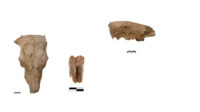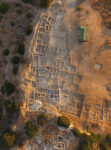 The skull of a bull has been discovered in a funerary building at the cemetery of the ancient Minoan palace of Petras in eastern Crete. The Minoan relationship with the bull is iconic, thanks largely to the legend of the Minotaur in the labyrinth of the Palace of Knossos, and to the ubiquity of the bull in Minoan art. Dating to between 1920 B.C. and 1750 B.C., this bull skull is the oldest evidence of an actual bull sacrifice found in a Minoan tomb.
The skull of a bull has been discovered in a funerary building at the cemetery of the ancient Minoan palace of Petras in eastern Crete. The Minoan relationship with the bull is iconic, thanks largely to the legend of the Minotaur in the labyrinth of the Palace of Knossos, and to the ubiquity of the bull in Minoan art. Dating to between 1920 B.C. and 1750 B.C., this bull skull is the oldest evidence of an actual bull sacrifice found in a Minoan tomb.
What are now low hills were peninsulas on two sides of a narrow gulf when Petras was founded around 3400 B.C. The remains of a palace and accompanying urban settlement have been discovered on the western hill. The eastern hill has remains of two settlements from different periods (3400 B.C.-2900 B.C. and 14th-12th c. B.C.). It was during the 2004 excavation of the eastern hill that the cemetery was discovered. Reserved for the elite of the palace settlement, it was in continuous use from 2800 B.C. to about 1750 B.C., and was in untouched, unplundered condition.
 The cemetery consists of 26 large burial buildings used as bone repositories rather than as primary burial sites. The funerary buildings have complex floor plans with as many as 14 rooms each. The rooms were rich with funary and ritual furnishings, including pottery, seal stones, jewelry, stone vessels, bronze tools and stone tools. Some rooms were used to store vessels used in funerary rituals. It is the largest cemetery of the Minoan Prepalatial (3500-1900 B.C.) and Protopalatial (1900-1750 B.C.) periods, and its long occupation and unlooted condition makes it a unique source of information about Minoan religion and culture.
The cemetery consists of 26 large burial buildings used as bone repositories rather than as primary burial sites. The funerary buildings have complex floor plans with as many as 14 rooms each. The rooms were rich with funary and ritual furnishings, including pottery, seal stones, jewelry, stone vessels, bronze tools and stone tools. Some rooms were used to store vessels used in funerary rituals. It is the largest cemetery of the Minoan Prepalatial (3500-1900 B.C.) and Protopalatial (1900-1750 B.C.) periods, and its long occupation and unlooted condition makes it a unique source of information about Minoan religion and culture.
The bull skull was discovered on the earthen floor of Area 8 of Funerary building 9.
“There were no other bones of the animal besides the cranium. Obviously the sacrifice took place at another cemetery section,” Tsipopoulou tells ANA-MPA. The cranium was accompanied by six vessels and two triton shells: a cup, three wide-spout pitchers (prochooi), a censor, and a lamp. The triton shells, “which are very important in Minoan religion (…) are something sacred, as are bulls,” the archaeologist notes. The vessels and shells were spread over the entire Area 8. Since the area was open to the sky, the lamp indicates it would either have been used to light the censor or to light the space if the ritual was held at night.
She says that the Minoan residents, as those in other regions of the world, would not mix rituals of death objects with daily objects. “The vessels would remain in the area (of the ritual), because, as in other societies, whatever was connected to death never returned to the residence complex to be used, but they used to break it and leave it in the cemetery areas.”
The style and date of the pottery secures the sacrificial placement to around 1850 BC. “We don’t know what prompted this elite family to sacrifice an extremely valuable animal,” Tsipopoulou says, “but perhaps it followed a strong earthquake or a pandemic or a dangerous and fatal natural phenomenon like a tsunami.” Bulls are associated with the sea in mythology, she notes.
A study of the bull cranium at Oxford University has revealed that the tongue was removed breaking the lower jaw after death but before deposition. Because the tongue was considered a delicacy, this is evidence that the bull was eaten before the skull was deposited. The analysis of the skull also indicated the bull was domesticated and about five years old when he died.